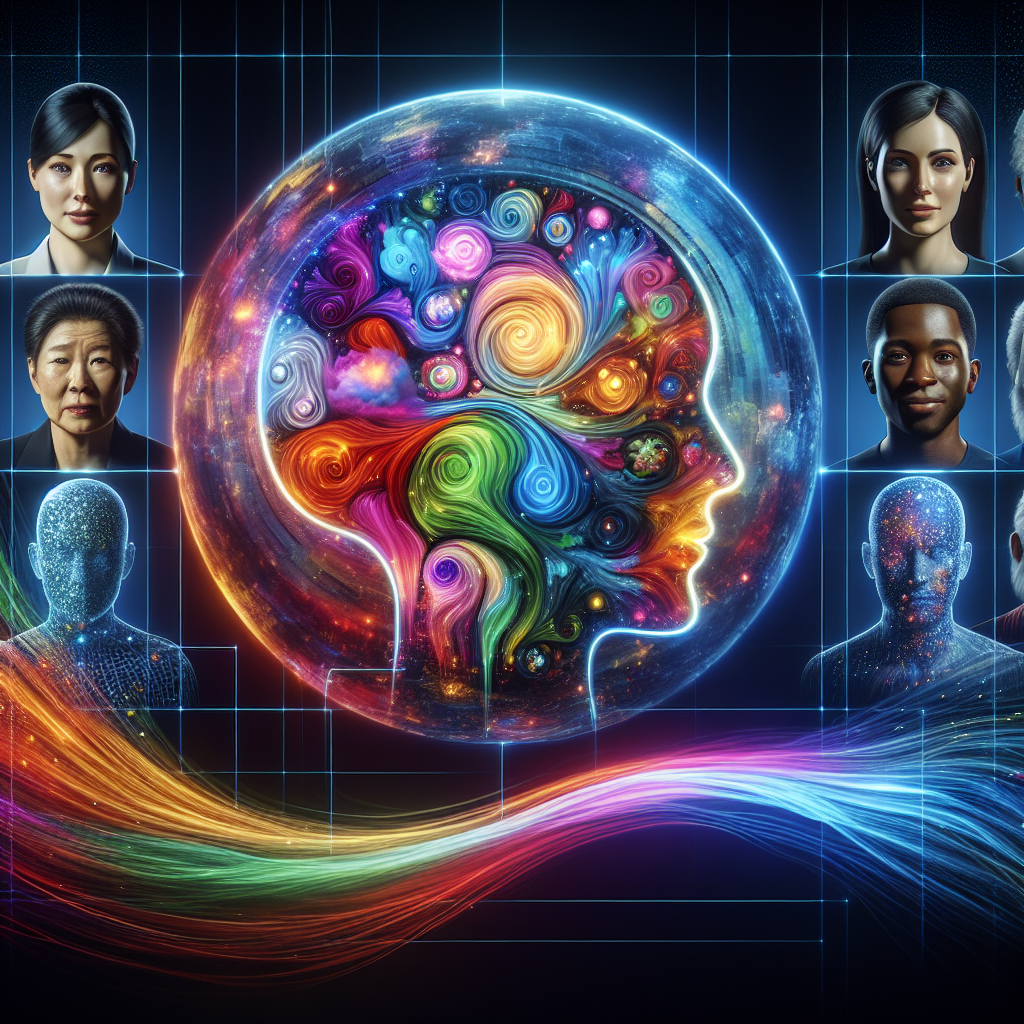Introduction
In an increasingly digital world, the ability to understand and respond to human emotions through technology has become a pivotal aspect of enhancing user experience and fostering meaningful interactions. Emotional AI, a burgeoning field within artificial intelligence, focuses on equipping machines with the capability to recognize, interpret, and respond to human emotions. This technological advancement holds the potential to revolutionize how we interact with digital platforms, making them more intuitive and empathetic. By training AI systems to detect emotional cues from text, voice, and facial expressions, we can create more personalized and emotionally intelligent digital environments. This not only improves user satisfaction but also builds trust and connection between humans and machines. As we delve into the realm of emotional AI training, we explore the methodologies and implications of enhancing digital empathy, paving the way for a future where technology seamlessly integrates with the emotional nuances of human interaction.
Understanding Emotional AI: The Future of Digital Empathy
In the rapidly evolving landscape of artificial intelligence, the concept of emotional AI has emerged as a pivotal area of exploration, promising to revolutionize the way machines interact with humans. Emotional AI, also known as affective computing, refers to the development of systems and devices that can recognize, interpret, and respond to human emotions. As technology becomes increasingly integrated into our daily lives, the ability of machines to understand and empathize with human emotions is becoming more crucial. This capability not only enhances user experience but also fosters a more profound connection between humans and technology.
The journey towards achieving digital empathy through emotional AI involves training algorithms to accurately detect and interpret emotional cues. These cues can be derived from various sources, such as facial expressions, voice intonations, and even physiological signals. By analyzing these indicators, emotional AI systems can infer the emotional state of a user and respond in a manner that is contextually appropriate. This process requires sophisticated machine learning models that are trained on vast datasets, encompassing a diverse range of emotional expressions and scenarios. As a result, the accuracy and reliability of emotional AI systems are continually improving, paving the way for more empathetic digital interactions.
One of the primary applications of emotional AI is in customer service, where it can significantly enhance the quality of interactions between customers and service providers. By understanding the emotional state of a customer, AI systems can tailor their responses to better address the customer’s needs and concerns. This personalized approach not only improves customer satisfaction but also builds trust and loyalty. Moreover, emotional AI can assist in identifying and de-escalating potentially tense situations, thereby preventing conflicts and ensuring a more harmonious interaction.
In addition to customer service, emotional AI holds promise in the realm of mental health support. By analyzing emotional patterns and detecting signs of distress, AI systems can provide timely interventions and support to individuals in need. This capability is particularly valuable in scenarios where human intervention may not be immediately available. Furthermore, emotional AI can serve as a valuable tool for mental health professionals, offering insights into a patient’s emotional state and facilitating more effective treatment plans.
Despite its potential, the development and deployment of emotional AI raise important ethical considerations. The collection and analysis of emotional data necessitate stringent privacy measures to protect user information. Additionally, there is a need for transparency in how emotional AI systems operate and make decisions. Ensuring that these systems are free from biases and that they respect cultural and individual differences is paramount to their successful integration into society.
As we look to the future, the continued advancement of emotional AI will likely lead to even more sophisticated and nuanced interactions between humans and machines. By enhancing digital empathy, emotional AI has the potential to transform not only how we interact with technology but also how we relate to one another in an increasingly digital world. As researchers and developers strive to refine these systems, the ultimate goal remains clear: to create technology that not only understands us but also genuinely empathizes with our emotions, thereby enriching our digital experiences and fostering a more connected and compassionate society.
Bridging the Gap: How Emotional AI Enhances Human-Computer Interaction
In the rapidly evolving landscape of technology, the integration of emotional artificial intelligence (AI) into human-computer interaction represents a significant leap forward. Emotional AI, which involves the development of systems capable of recognizing, interpreting, and responding to human emotions, is poised to bridge the gap between humans and machines, enhancing the quality and depth of interactions. As digital interfaces become increasingly prevalent in our daily lives, the ability of machines to understand and respond to human emotions is not just a luxury but a necessity.
To begin with, the concept of emotional AI is rooted in the understanding that emotions play a crucial role in human communication. Traditional AI systems, while efficient in processing data and executing tasks, often lack the nuanced understanding of human emotions that is essential for more natural and effective interactions. By training AI systems to recognize emotional cues such as facial expressions, tone of voice, and even physiological signals, developers aim to create machines that can engage with users on a more personal and empathetic level. This capability is particularly important in fields such as customer service, healthcare, and education, where emotional understanding can significantly enhance user experience and outcomes.
Moreover, the implementation of emotional AI in human-computer interaction is not without its challenges. One of the primary concerns is ensuring the accuracy and reliability of emotion recognition systems. Emotions are complex and can be expressed in myriad ways, often influenced by cultural, social, and individual factors. Therefore, training AI systems to accurately interpret these signals requires extensive data and sophisticated algorithms. Additionally, there is the challenge of ensuring that these systems respect user privacy and data security, as the collection and analysis of emotional data can be sensitive.
Despite these challenges, the potential benefits of emotional AI are substantial. For instance, in customer service, emotionally intelligent AI can lead to more satisfying interactions by recognizing when a customer is frustrated or confused and responding appropriately. In healthcare, emotional AI can assist in monitoring patients’ emotional well-being, providing valuable insights for mental health professionals. In education, AI systems that understand students’ emotional states can offer personalized learning experiences, adapting to the needs and moods of individual learners.
Furthermore, the development of emotional AI also raises important ethical considerations. As machines become more adept at understanding and responding to human emotions, it is crucial to ensure that these technologies are used responsibly and ethically. This includes addressing issues such as consent, transparency, and the potential for manipulation. Developers and policymakers must work together to establish guidelines and regulations that protect users while fostering innovation.
In conclusion, the integration of emotional AI into human-computer interaction holds the promise of more empathetic and effective digital experiences. By bridging the gap between human emotions and machine responses, emotional AI has the potential to transform the way we interact with technology, making it more intuitive and human-centered. As we continue to explore the possibilities of this technology, it is essential to address the challenges and ethical considerations that accompany its development. Through careful and thoughtful implementation, emotional AI can enhance our digital interactions, ultimately leading to a more connected and understanding world.
Emotional AI in Customer Service: Creating More Empathetic Experiences

In the rapidly evolving landscape of customer service, the integration of emotional artificial intelligence (AI) is becoming increasingly pivotal. As businesses strive to create more empathetic experiences for their customers, emotional AI emerges as a transformative tool that can bridge the gap between human emotions and digital interactions. By training AI systems to recognize and respond to human emotions, companies can enhance their customer service strategies, fostering deeper connections and improving overall satisfaction.
To begin with, emotional AI refers to the technology that enables machines to detect and interpret human emotions through various data inputs, such as facial expressions, voice tone, and text analysis. This capability is particularly valuable in customer service, where understanding a customer’s emotional state can significantly influence the outcome of an interaction. For instance, a customer expressing frustration over a product issue requires a different approach than one who is simply seeking information. By accurately identifying these emotional cues, AI systems can tailor their responses to better meet the customer’s needs, thereby creating a more personalized and empathetic experience.
Moreover, the implementation of emotional AI in customer service is not just about recognizing emotions but also about responding appropriately. This involves training AI models to simulate empathy, a complex human emotion that involves understanding and sharing the feelings of others. Through advanced algorithms and machine learning techniques, AI can be programmed to offer empathetic responses that acknowledge the customer’s emotions and provide reassurance. This not only helps in de-escalating tense situations but also builds trust and rapport between the customer and the brand.
Furthermore, the benefits of emotional AI extend beyond individual interactions. By analyzing emotional data on a larger scale, companies can gain valuable insights into customer sentiment and behavior patterns. This information can be used to identify common pain points, improve service processes, and develop more effective communication strategies. Consequently, businesses can enhance their overall customer experience, leading to increased loyalty and retention.
However, the integration of emotional AI in customer service is not without its challenges. One of the primary concerns is ensuring the accuracy and reliability of emotion detection. Emotions are inherently complex and can be influenced by various factors, making it difficult for AI systems to interpret them with complete precision. To address this issue, continuous training and refinement of AI models are essential. This involves using diverse and representative datasets to improve the system’s ability to recognize a wide range of emotional expressions across different demographics and contexts.
Additionally, ethical considerations must be taken into account when deploying emotional AI. Privacy concerns arise from the collection and analysis of personal data, necessitating robust data protection measures and transparent practices. Companies must ensure that their use of emotional AI aligns with ethical standards and respects customer privacy, thereby maintaining trust and credibility.
In conclusion, emotional AI holds significant potential for enhancing customer service by creating more empathetic experiences. Through the accurate detection and appropriate response to human emotions, AI can transform digital interactions into meaningful connections. While challenges remain, ongoing advancements in AI technology and a commitment to ethical practices will pave the way for more effective and empathetic customer service solutions. As businesses continue to explore the possibilities of emotional AI, they are poised to redefine the future of customer engagement, ultimately leading to more satisfied and loyal customers.
The Role of Emotional AI in Mental Health Support
In recent years, the integration of artificial intelligence into various sectors has revolutionized the way we approach complex challenges, and mental health support is no exception. Emotional AI, a subset of artificial intelligence focused on recognizing and responding to human emotions, is increasingly being leveraged to enhance digital empathy in mental health services. This innovative approach aims to bridge the gap between technology and human emotional needs, offering a promising avenue for more personalized and effective mental health support.
At the core of emotional AI is the ability to analyze and interpret human emotions through data inputs such as facial expressions, voice tone, and text sentiment. By training AI systems to recognize these emotional cues, developers are creating tools that can respond with a level of empathy that was previously unattainable in digital interactions. This capability is particularly significant in mental health support, where understanding and responding to a person’s emotional state is crucial for effective intervention.
One of the primary benefits of emotional AI in mental health is its potential to provide immediate support to individuals in distress. Traditional mental health services often face challenges such as long waiting times and limited accessibility, which can be barriers to timely care. Emotional AI can help mitigate these issues by offering real-time analysis and feedback, allowing individuals to receive support when they need it most. For instance, AI-driven chatbots equipped with emotional intelligence can engage users in conversations, offering comfort and guidance while assessing their emotional state. This immediate interaction can be a critical first step in providing relief and directing individuals to appropriate resources.
Moreover, emotional AI can enhance the personalization of mental health support. By continuously learning from interactions, AI systems can tailor their responses to the unique emotional patterns and needs of each user. This personalized approach not only improves the user experience but also increases the likelihood of positive outcomes. As the AI becomes more adept at understanding individual emotional nuances, it can offer more targeted interventions, whether through suggesting coping strategies, recommending professional help, or simply providing a sympathetic ear.
However, the integration of emotional AI into mental health support is not without its challenges. Ensuring the accuracy and reliability of emotional AI systems is paramount, as misinterpretations of emotional data could lead to inappropriate responses and potentially harm users. Therefore, ongoing research and development are essential to refine these systems and enhance their ability to accurately interpret complex human emotions. Additionally, ethical considerations, such as data privacy and consent, must be addressed to build trust and ensure that users feel safe when interacting with AI-driven mental health tools.
In conclusion, emotional AI holds significant promise for enhancing digital empathy in mental health support. By providing immediate, personalized, and empathetic interactions, these systems can complement traditional mental health services and offer a valuable resource for individuals seeking help. As technology continues to evolve, the potential for emotional AI to transform mental health support is vast, offering hope for more accessible and effective care. However, it is crucial to approach this integration with caution, ensuring that ethical standards are upheld and that the technology is continually refined to meet the complex needs of those it aims to serve. Through careful development and implementation, emotional AI can play a pivotal role in shaping the future of mental health support, fostering a more empathetic and responsive digital landscape.
Training Emotional AI: Techniques for Developing Digital Empathy
In the rapidly evolving landscape of artificial intelligence, the development of emotional AI stands as a pivotal frontier. As technology becomes increasingly integrated into our daily lives, the ability of machines to understand and respond to human emotions is not just a luxury but a necessity. Emotional AI, often referred to as affective computing, aims to bridge the gap between human emotions and machine responses, thereby enhancing digital empathy. This endeavor requires sophisticated training techniques that enable AI systems to accurately interpret and react to the nuanced spectrum of human emotions.
To begin with, the foundation of training emotional AI lies in the collection and analysis of vast datasets that encompass a wide range of emotional expressions. These datasets are typically derived from diverse sources, including facial expressions, voice intonations, and physiological signals. By employing machine learning algorithms, AI systems can be trained to recognize patterns and correlations within these datasets, allowing them to infer emotional states with increasing accuracy. However, the challenge lies not only in data collection but also in ensuring that the data is representative of the diverse emotional expressions found across different cultures and contexts.
Moreover, the integration of natural language processing (NLP) techniques plays a crucial role in developing digital empathy. NLP enables AI systems to comprehend and interpret the subtleties of human language, including tone, sentiment, and context. By analyzing textual data, such as social media posts or customer service interactions, AI can gauge the emotional undertones of a conversation. This capability is particularly valuable in applications like virtual assistants and customer support, where understanding the user’s emotional state can significantly enhance the quality of interaction.
In addition to data-driven approaches, the incorporation of reinforcement learning techniques offers a dynamic method for training emotional AI. Through reinforcement learning, AI systems can learn from interactions with humans, receiving feedback that helps refine their emotional understanding. This iterative process allows AI to adapt to new emotional cues and contexts over time, thereby improving its empathetic responses. For instance, a virtual therapist could use reinforcement learning to better understand a patient’s emotional needs, providing more personalized and effective support.
Furthermore, the ethical considerations surrounding emotional AI training cannot be overlooked. As AI systems become more adept at interpreting emotions, concerns about privacy and consent arise. It is imperative that developers adhere to ethical guidelines, ensuring that emotional data is collected and used responsibly. Transparency in how AI systems process and utilize emotional information is essential to building trust with users and safeguarding their emotional well-being.
In conclusion, the development of digital empathy through emotional AI training is a multifaceted endeavor that requires a combination of advanced data analysis, natural language processing, and reinforcement learning techniques. As these technologies continue to evolve, they hold the potential to transform the way we interact with machines, making them more attuned to our emotional needs. However, it is crucial to navigate this path with ethical considerations in mind, ensuring that the benefits of emotional AI are realized without compromising individual privacy and autonomy. By fostering a deeper understanding of human emotions, emotional AI can pave the way for more empathetic and meaningful interactions between humans and machines, ultimately enhancing the quality of our digital experiences.
Ethical Considerations in Emotional AI: Balancing Empathy and Privacy
In the rapidly evolving landscape of artificial intelligence, emotional AI stands out as a particularly intriguing and complex field. This technology, designed to recognize, interpret, and respond to human emotions, holds the potential to revolutionize how machines interact with people. However, as with any powerful tool, the integration of emotional AI into everyday life necessitates a careful examination of ethical considerations, particularly in balancing empathy and privacy.
At the heart of emotional AI is the aspiration to create machines that can understand and respond to human emotions in a way that feels natural and supportive. This capability could enhance user experiences across various domains, from customer service to mental health support. By training AI systems to detect emotional cues such as facial expressions, tone of voice, and even physiological signals, developers aim to create more empathetic interactions. This, in turn, could lead to more personalized and effective services, fostering a sense of connection between humans and machines.
However, the pursuit of digital empathy raises significant ethical questions, particularly concerning privacy. Emotional AI systems often require access to sensitive personal data to function effectively. This data can include video and audio recordings, biometric information, and other intimate details that individuals may not wish to share. Consequently, there is a pressing need to establish robust frameworks that protect user privacy while allowing emotional AI to flourish.
One of the primary challenges in this regard is ensuring informed consent. Users must be fully aware of what data is being collected, how it will be used, and the potential risks involved. Transparency is crucial, as it empowers individuals to make informed decisions about their interactions with emotional AI systems. Moreover, developers must prioritize data security, implementing stringent measures to prevent unauthorized access and misuse of personal information.
In addition to privacy concerns, there is the question of how emotional AI might influence human behavior. As these systems become more adept at mimicking empathy, there is a risk that individuals may form attachments to machines, potentially impacting their relationships with other humans. This phenomenon, known as the “Eliza effect,” highlights the importance of setting clear boundaries between human and machine interactions. Developers must ensure that emotional AI systems are designed to complement, rather than replace, human empathy.
Furthermore, the potential for bias in emotional AI systems cannot be overlooked. These systems are trained on vast datasets, which may inadvertently reflect societal biases. If not addressed, this could lead to AI systems that misinterpret or unfairly judge certain emotional expressions based on race, gender, or cultural background. To mitigate this risk, it is essential to incorporate diverse data sources and continuously evaluate AI models for bias.
In conclusion, while emotional AI offers exciting possibilities for enhancing digital empathy, it also presents significant ethical challenges. Balancing the benefits of empathetic machines with the need to protect individual privacy requires a thoughtful and proactive approach. By prioritizing transparency, informed consent, and data security, developers can create emotional AI systems that respect user privacy while fostering meaningful interactions. Moreover, by addressing potential biases and setting clear boundaries, we can ensure that emotional AI serves as a valuable tool for enhancing human experiences without compromising ethical standards. As we continue to explore the capabilities of emotional AI, it is imperative that we remain vigilant in addressing these ethical considerations, ensuring that technology serves humanity in a responsible and respectful manner.
Case Studies: Successful Implementations of Emotional AI in Various Industries
In recent years, the integration of emotional artificial intelligence (AI) into various industries has demonstrated significant potential in enhancing digital empathy. By analyzing and responding to human emotions, emotional AI systems are transforming the way businesses interact with their customers and employees. Several case studies highlight the successful implementation of emotional AI, showcasing its ability to foster more empathetic and effective communication across different sectors.
One notable example of emotional AI in action is within the customer service industry. Companies have begun deploying AI-driven chatbots equipped with emotional recognition capabilities to improve customer interactions. These chatbots can analyze vocal tones, facial expressions, and text sentiment to gauge a customer’s emotional state. For instance, a leading telecommunications company implemented an emotional AI system that allowed their virtual assistants to detect frustration in a customer’s voice. Consequently, the system could escalate the issue to a human representative or offer tailored solutions to alleviate the customer’s concerns. This approach not only enhanced customer satisfaction but also streamlined the resolution process, demonstrating the value of emotional AI in creating more empathetic customer service experiences.
Transitioning to the healthcare sector, emotional AI has been instrumental in improving patient care and outcomes. Hospitals and clinics have started using AI-powered tools to monitor patients’ emotional well-being, particularly in mental health settings. For example, a mental health app developed by a tech startup uses emotional AI to analyze users’ speech patterns and facial expressions during video therapy sessions. By identifying signs of anxiety or depression, the app provides therapists with valuable insights into their patients’ emotional states, enabling more personalized and effective treatment plans. This innovative use of emotional AI underscores its potential to revolutionize mental health care by fostering deeper understanding and empathy between patients and healthcare providers.
In the realm of education, emotional AI is being utilized to enhance the learning experience for students. Educational technology companies have developed AI systems that can assess students’ emotional engagement and adjust teaching methods accordingly. A prominent case involves an online learning platform that uses emotional AI to track students’ facial expressions and body language during virtual classes. By identifying signs of confusion or boredom, the platform can modify the content delivery or provide additional resources to re-engage students. This adaptive learning approach not only improves educational outcomes but also creates a more supportive and empathetic learning environment.
Moreover, the retail industry has also embraced emotional AI to better understand consumer behavior and preferences. Retailers are leveraging AI-driven analytics to interpret customers’ emotional responses to products and marketing campaigns. For instance, a major fashion brand implemented an emotional AI system to analyze shoppers’ reactions to new clothing lines through in-store cameras and online feedback. By understanding customers’ emotional connections to their products, the brand was able to tailor its offerings and marketing strategies to better align with consumer desires, ultimately enhancing customer loyalty and sales.
In conclusion, the successful implementation of emotional AI across various industries highlights its transformative potential in enhancing digital empathy. By enabling more nuanced and empathetic interactions, emotional AI systems are not only improving customer service, healthcare, education, and retail experiences but also paving the way for more human-centered technology solutions. As emotional AI continues to evolve, its ability to foster deeper connections and understanding between humans and machines will undoubtedly play a crucial role in shaping the future of industry and society.
Conclusion
Enhancing digital empathy through emotional AI training involves developing artificial intelligence systems that can recognize, interpret, and respond to human emotions in a way that mimics human empathy. By integrating advanced machine learning algorithms and natural language processing, these systems can analyze vocal tones, facial expressions, and textual cues to gauge emotional states. The goal is to create AI that can engage more naturally and empathetically with users, improving user experience and satisfaction. However, challenges remain in ensuring privacy, avoiding bias, and maintaining ethical standards. Ultimately, emotional AI training holds the potential to transform human-computer interactions by making them more intuitive and emotionally aware, fostering deeper connections between humans and technology.




Leave a Reply